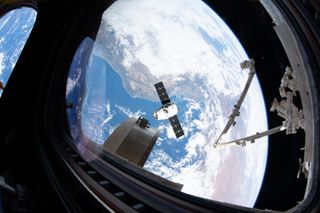You Can Watch a SpaceX Dragon Cargo Ship Return to Earth Tuesday. Here's How.

A SpaceX Dragon cargo resupply spacecraft will undock from the International Space Station Tuesday (Jan. 7) to begin a 5-hour journey back to Earth, and you can watch its departure live online.
The unpiloted Dragon capsule, flying on a mission called CRS-19, is scheduled to leave the orbiting laboratory at 5:03 a.m. EST (1003 GMT), when mission controllers in Houston will command the station's Canadarm2 robot arm to release it into space. You can watch a live webcast of the Dragon's departure live here on Space.com, courtesy of NASA TV, beginning at 4:45 a.m. EST (0945 GMT).
After firing its thrusters to maneuver away from the station, the Dragon will execute a deorbit burn that will send it plummeting into Earth's atmosphere, where it will conduct a parachute-assisted splashdown around 10:47 a.m. EST (1547 GMT), in the Pacific Ocean southwest of Long Beach, California. NASA and SpaceX will not provide live coverage of the splashdown.
Related: SpaceX's Amazing CRS-18 Dragon Flight for NASA in Photos
The used CRS-19 vessel launched to the space station for the third time on Dec. 5; it previously flew on SpaceX's CRS-4 mission in 2014, followed by the CRS-11 mission in 2017, when it became the first Dragon capsule to complete a second cargo run.
It arrived at the station on Dec. 8 with more than 5,700 lbs. (2,585 kilograms) of supplies, including more than 2,100 lbs. (952 kg) of science equipment for the astronauts of Expeditions 61 and 62.
Dragon will return to Earth with 3,600 lbs. (1,633 kg) of experiments, including a so-called "mighty mice" for studying muscle and bone loss, a radiation resistance experiment involving "tiny aquatic animals called rotifers, as well as a series of crystal growth demonstrations.
Get the Space.com Newsletter
Breaking space news, the latest updates on rocket launches, skywatching events and more!
- How SpaceX's Dragon Space Capsule Works (Infographic)
- SpaceX Dragon Capsule Returns to Earth with NASA Science Haul
- Used SpaceX Dragon Cargo Ship Arrives at Space Station for Record 3rd Time
Email Hanneke Weitering at hweitering@space.com or follow her @hannekescience. Follow us on Twitter @Spacedotcom and on Facebook.

Join our Space Forums to keep talking space on the latest missions, night sky and more! And if you have a news tip, correction or comment, let us know at: community@space.com.

Hanneke Weitering is a multimedia journalist in the Pacific Northwest reporting on the future of aviation at FutureFlight.aero and Aviation International News and was previously the Editor for Spaceflight and Astronomy news here at Space.com. As an editor with over 10 years of experience in science journalism she has previously written for Scholastic Classroom Magazines, MedPage Today and The Joint Institute for Computational Sciences at Oak Ridge National Laboratory. After studying physics at the University of Tennessee in her hometown of Knoxville, she earned her graduate degree in Science, Health and Environmental Reporting (SHERP) from New York University. Hanneke joined the Space.com team in 2016 as a staff writer and producer, covering topics including spaceflight and astronomy. She currently lives in Seattle, home of the Space Needle, with her cat and two snakes. In her spare time, Hanneke enjoys exploring the Rocky Mountains, basking in nature and looking for dark skies to gaze at the cosmos.
